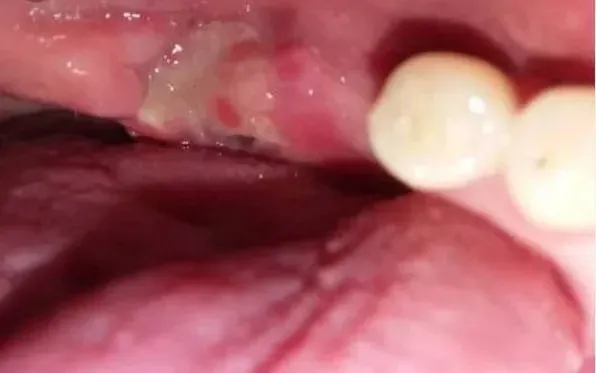Blood Clot Fell Out 3 Days After Tooth Extraction? Don’t Panic (Here’s What to Do)
Having a tooth pulled is stressful enough… but realizing that your tooth extraction blood clot fell…
Having a tooth pulled is stressful enough… but realizing that your tooth extraction blood clot fell out can send you straight into panic mode. You look in the mirror, see an empty hole, and thousands of questions race through your mind: Is this a dry socket? Will it hurt? What should I do right now?
Take a deep breath. While losing a clot is a complication, it does not always mean disaster. In this guide, you’ll learn exactly what the blood clot does, how to tell if it’s really gone (or if it’s just normal healing white tissue), immediate steps to stop bleeding, and how to prevent the dreaded dry socket.
The goal is simple: calm your nerves, protect the extraction site, and get you back on the path to healing.
⚠️ Important: This article is for information only. If you have uncontrollable bleeding or severe pain radiating to your ear, call your dentist immediately.
Why Is the Blood Clot So Important?
When a dentist removes a tooth, it leaves behind an empty socket in the jawbone. Almost immediately, your body acts to plug this hole. It sends blood cells to form a blood clot inside the socket.
Think of this clot as a “natural biological bandage.” It serves three critical roles:
- Protection: It covers the exposed bone and sensitive nerve endings deep in the socket, shielding them from air, food, and bacteria.
- Foundation: It acts as a scaffold for new tissue to grow. This new growth is called granulation tissue.
- Pain Relief: By covering the nerves, it significantly reduces dental pain and sensitivity.
If this blood clot becomes dislodged or falls out prematurely, you lose this protective layer. This can lead to a dry socket, but not always.
How Do I Know If the Blood Clot Fell Out? (Signs vs. False Alarms)
This is the most common confusion. Many people mistake normal healing for a lost clot. Here is how to tell the difference:
Signs the Clot Actually Fell Out:
- The “Empty” Look: The socket looks like a dark, deep hole, or you can see a whitish-grey hard surface deep inside (that’s the exposed bone).
- Renewed Bleeding: You suddenly taste blood or see fresh bleeding after the first 24 hours.
- Bad Taste: A distinct foul taste or smell in your mouth that won’t go away.
- Pain Spike: You were feeling better, but suddenly the pain gets worse.
False Alarm: The “White Stuff” (Granulation Tissue) If you see something white or creamy-colored in the socket, don’t panic! This is usually granulation tissue. It is a sign that the healing process is working perfectly.
- Rule of Thumb: If you see white stuff and have no pain, you are healing fine. If you see white stuff (bone) and have severe pain, that is a problem.
Immediate Action Plan: What to Do Right Now
If you suspect the tooth extraction blood clot fell or became dislodged, follow these steps immediately to encourage a new clot to form and protect the socket:
- Stay Calm: Stress increases blood pressure, which can make bleeding worse.
- Check for Bleeding: Is it actively bleeding?
- If YES: You need to apply pressure. Fold a piece of [Sterile Dental Gauze] into a small square, place it directly over the socket, and bite down firmly for 30-45 minutes. Pressure is the key to stopping bleeding.
- Tip: If you don’t have gauze, a wet black tea bag can work (the tannic acid helps clotting).
- Do Not Rinse Yet: Vigorous rinsing can wash away any new fragile clot forming.
- Rest & Elevate: Lie down with your head propped up on pillows to reduce blood flow to the head.
The “Day 3” Danger Zone: Dry Socket Explained
You might have heard horror stories about Dry Socket (Alveolar Osteitis). It is the most common complication, especially after wisdom teeth removal.
Why Day 3? Search data shows many people ask about “blood clot fell out 3 days after tooth extraction.” This is because the clot naturally shrinks around day 3. If it falls out completely at this stage, the bone becomes exposed before new tissue has covered it.
Symptoms of Dry Socket:
- Severe Pain: Intense, throbbing pain that starts 2-4 days after extraction.
- Radiating Pain: Pain that shoots up to your ear, eye, or neck on the same side.
- Empty Socket: Visible bone in the socket.
- Bad Breath: A strong, unpleasant odor.
Dry Socket Relief (Emergency Home Care): If you can’t see a dentist immediately, the gold standard for relief is Natural Clove Oil. It contains Eugenol, a powerful natural anesthetic used by dentists for decades.
Does a Lost Clot Always Mean Dry Socket?
Here is the good news: No.
- Scenario A (High Risk): The clot falls out on Day 1 or 2, and you are in severe pain. -> High risk of Dry Socket.
- Scenario B (Low Risk): A piece of the clot comes out on Day 4 or 5, but you have no pain. -> You are likely fine.
The body has a backup plan. If the main clot is lost but the socket is small or healing has started, the body can often heal by “secondary intention” (filling in from the bottom up). If there is no pain, there is usually no problem.
How to Prevent the Clot from Falling Out (The “Don’ts”)
To ensure the healing process goes smoothly, avoid these clot-killers for the first 72 hours:
- No Suction: This is the #1 enemy.
- NO Straws: The vacuum force pulls the clot out instantly.
- NO Smoking/Vaping: The sucking motion + chemicals = high risk of dry socket.
- “If you’re a smoker, it’s important to understand the risks—learn more about smoking after tooth extraction.”
- NO Spitting: Let saliva drool out gently; don’t spit forcefully.
- Watch Your Food:
- Eat soft foods (yogurt, mashed potatoes, lukewarm soup).
- Avoid crunchy, crumbly foods (chips, nuts) that can get stuck in the empty socket.
- Gentle Hygiene:
- Brush your other teeth normally but skip the extraction site for the first day.
- From Day 2, rinse very gently with warm salt water to keep the area clean without disturbing the clot.
When to Call Your Dentist
While you can manage minor issues at home, you should call your dentist or oral surgeon if:
- Bleeding won’t stop after 1-2 hours of pressure.
- You have severe pain that is not helped by painkillers.
- You see signs of infection (fever, swelling, pus).
- You suspect a dry socket and need professional dressing to relieve the pain.
Key Takeaways:
Avoid straws, smoking, and spitting for at least 3 days.
The blood clot is your body’s bandage; protect it!
White stuff in the socket is usually good healing tissue, not a lost clot.
If the clot falls out but you have no pain, you are likely okay.
Use [Sterile Gauze] for bleeding and [Natural Clove Oil] for dry socket pain relief.








